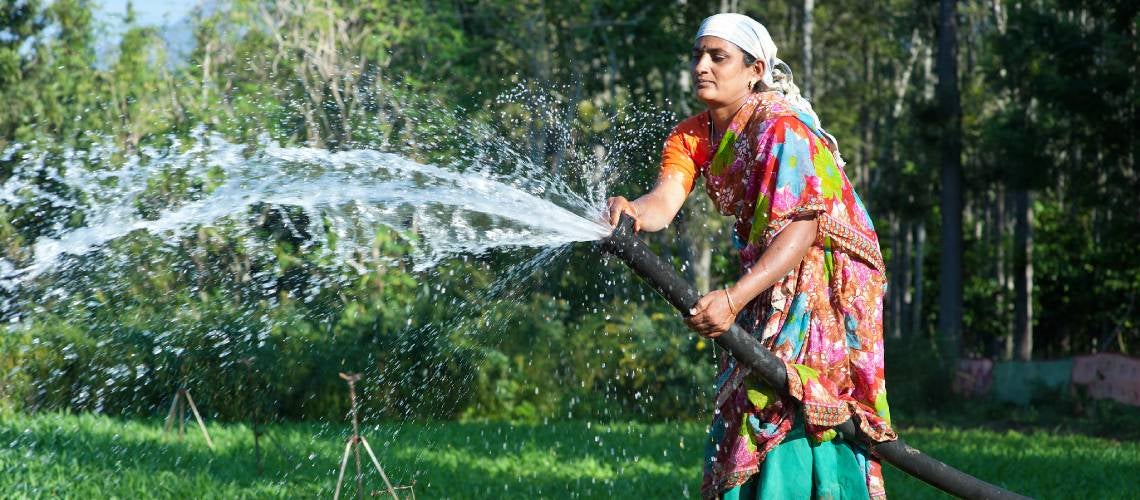 A woman waters her garden in India. Photo: Hamish John Appleby/IWMI
A woman waters her garden in India. Photo: Hamish John Appleby/IWMI
In the recently concluded UN Water Conference, the issue of money, and how to secure more of it, was front and center in numerous sessions and discussions. And as water becomes fully embedded in the climate discussions, the urgency to secure more financial resources was a major focus of efforts to address water-related adaptation and mitigation issues, as well as efforts to close the irrigation and water and sanitation gap for billions across the globe.
However, while the potential role of the private sector was touted by nearly all the participants, there was very little consensus on how to ultimately pay for private sector participation in these services. In other words, where was the revenue going to come from to pay for private sector services, much less public investment? Terms such as blended finance, leveraging, Public Private Partnerships, Blue Bonds and climate finance were discussed at length and there was some implication that these instruments could provide the trillions of dollars that are urgently needed. However, until the water sector addresses the underlying challenges inhibiting creditworthiness, new sources of revenue aren’t likely to flow to the water sector.
Tariffs or Taxes, or Trouble?
Few of the world’s water related challenges are easy to explain, but what is very, very clear is that there are primarily two ways to pay for water infrastructure. Either the consumer pays through tariffs, or the fiscus pays through taxes (or some combination of these two). Simply put, there is no other source of revenue to pay for water services. Despite all our ingenuity, all our financial engineering skills, and all our efforts to mitigate the burden of tariffs on consumers and particularly the poor, the only alternative to tariffs is for the Ministry of Finance or Treasury to foot the bill. Whether one sits in Stockholm or Nairobi, Lima or Manila, water and sanitation services are always paid for either by tariffs or taxes. There is simply no other source of revenue to pay for these services…..
…..unless they’re not paid by either, and that’s when the water sector gets into real trouble. The vicious cycle of “build and neglect” is a result of multiple factors, but one of the most challenging is the lack of revenue being generated to support water services. This occurs because there are poor collection rates, low tariffs, and\or the inability to make compelling arguments to key policy makers to bring more public money to the sector. Instead, in too many places there is the cycle of “building” water infrastructure, and then “neglecting” it by not maintaining or repairing these assets because the resources aren’t available.
And yet this can be turned around. Recent analysis done by the World Bank found that the expenditure rate on public budgets supporting WASH services had an execution rate of 70%. In effect, 30% of the resources already in national budgets remained unspent at the end of the year. And efforts to better support our poorest residents, while good intentioned, aren’t being executed effectively. Another World Bank study found that nearly 60% of subsidies, designed to serve those most in need, instead go to the wealthiest residents. But there is a way forward. Perhaps most importantly, the WASH sector can improve its management and delivery, especially for the poor. Higher tariffs do most certainly affect the poorest and provisions and policies need to be put in place to mitigate the impact on our most vulnerable citizens. There is also a need for better planning and implementation so water providers can effectively utilize our existing funding; it’s hard to plead for more resources, public or private, if you aren’t spending the money that’s been allocated. More specifically, if local governments, water utilities, and other providers can significantly improve their collection systems, reduce non-revenue water, and decrease energy costs, many of them can become viable, efficient, and bankable service providers.
If Securing Revenue from Water and Sanitation is Hard, Look at Irrigation
Despite all the attention on water and sanitation services, some 70% of our water supply is used to grow food. Yet in many markets only a small percentage of that water is actually paid for, including irrigation schemes which are growing in importance as the world faces increasing populations, changing climates and food insecurity. Some countries actually prohibit charges or tariffs for irrigation services and, when tariffs are in place, like water and sanitation services, collection rates are low.
According to recent analysis by the World Bank, irrigation covers only 6.5% of the land supporting agriculture. Yet it supports 40% of the world’s food and fodder output. And this isn’t just an emerging market issue. So in light of our growing hydrological changes, diminishing water resources, and increasing populations, why isn’t there more investment in sustainable irrigation systems?
Once again, the lack of revenue is one of the major culprits and, yet again it has been hard to deal with these underlying challenges. Like water and sanitation services, the road to revenue to maintain and build more irrigation is through improved services. Water losses need to be reduced, technology needs to be enhanced to decrease energy costs, operational efficiencies must be found, and more transparent, rigorous governance and management systems need to be put in place. These improvements will help secure a sustainable revenue stream, not only to maintain our systems, but expand them as well.
We Know How to Address Our Water, Revenue and Finance Challenges
After nearly a half century of the “build and neglect” cycle undermining our water infrastructure and assets, we now find ourselves with an increasing population in a rapidly changing climate and a global food crisis. To deal with this very real challenge of funding revenue to build and maintain our water infrastructure, the sector needs to focus on the demand for financial resources, not the supply of money. More specifically, our providers, whether utilities or irrigation agencies, need to become more technically and financially efficient, and our governance and regulatory environments need to become more rigorous and transparent. Then, over time, these providers will become more viable and bankable, and the desperately needed resources will finally flow to the water sector.
Related Links:
Closing the financial gap: Take the new e-Learning course on Water Utility Creditworthiness!
Improved governance and increased investment needed to tackle world water crisis
How to improve water-sector financing in developing countries
Public spending in the water sector: What do we know?
Blended Finance: a key to achieve universal access to water supply and sanitation by 2030
Leveraging commercial finance for water: Will it hurt the poor?


Join the Conversation